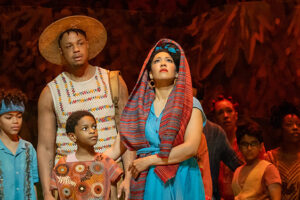

The performance of Wednesday, November 24 was, with few exceptions, a major disappointment. There was some good singing, some individual sparks of vocal fire, but those sparks died away without igniting. The major problem with the performance was, sadly for me, the utterly lifeless stage direction of Scotto. The brilliant dramatic insights that the great soprano brought to her vast range of performances was nowhere in evidence at the Civic Opera House. Nearly every scene was blocked with principals downstage center, facing the audience, with chorus arranged in a semi-circular line upstage and around them, also facing the audience. Only very rarely did these passionate characters ever look at, or sing directly to, each other.
The result was a nearly static, moribund staging that allowed for bravura singing but completely undercut the dramatic action of Verdi’s masterpiece. Even the desperately passionate love duet “Teco io sto” in Act II fizzled, with no dramatic connection either physically or emotionally between Gustavo and Amelia, forced to sing to each other across a wide expanse of the proscenium.
The staging improved a bit with the elegant Act III ball scene, but even here there were problems. After Renato shoots Gustavo, the chorus sings curses at the assassin, and the benevolent Gustavo sings “Let him be” in the supertitles. Well, no one appeared even remotely interested in arresting or molesting Renato, even the King’s guards—everyone just stood there in rigid formation. I kept waiting for the moments of inventiveness or dramatic surprise that I expected of Scotto, but the palpably disappointed audience and I waited in vain.
The singing was uniformly good, and in some cases excellent. The glory of this production was Stephanie Blythe’s Lyric debut as Mme. Arvidson (Ulrica). When she unleashed her first clarion phrase, we knew the evening had come to life. Blythe’s voice had great power, wonderfully even tone, and a great use of variation in volume from exquisite pianissimo to stunning forte moments. She received a huge, much deserved ovation at her curtain call following Act 1.
The fine Verdi soprano Sondra Radvanovsky gave us a stunning, emotionally vibrant Amelia, with wonderful piercing high notes. Still, I had the feeling that she is not yet a very good fit in this role. Amelia has a lot of singing in the middle and lower voice, probably Radvanovsky’s weakest areas, and the low notes frequently disappeared into the orchestra. It must be noted, however, that her great aria “Morro, ma prima in grazia” found the soprano using her considerable resources to powerful effect. The aria was both beautiful and deeply moving, and was one of the few moments in the performance where the audience was riveted by the passionate singing.
Tiny soprano Kathleen Kim mugged gamely and acts appropriately boyish as Oscar, but only in her third act teasing of Renato, “saper vorreste”, did she manage to make a strong effect.
I found the men more problematic. Frank Lopardo as Gustavo sang with his characteristic grace and excellent phrasing—he is becoming the John Alexander of today. But his attempts at character—initial swaggering, later dignified suffering—mostly fell flat. It was a “white bread” performance that was always competent but never came close to thrilling. Lopardo played it safe, and his performance was lacking in passion and excitement.
Baritone Mark Delavan started very slowly; in fact, his first line was so croaked and foggy that I wondered if he was ill. His performance improved steadily throughout, however, as he seemed to warm to the role, and he gave us a stentorian, gutsy “Eri tu”, though the forte notes seemed pushed.
Production values were conservative, but quite beautiful. The sets, which I understand were the work of Zach Brown (though he took his name off the production and is uncredited here) are quite fine, though one wonders why Renato’s home has the same floor design as Gustavo’s court. They shared a decorator, perhaps? John Conklin’s costumes are lush and appropriate to the Swedish setting. The lighting of Christine Binder attempts to create mood, but just comes off as dark and darker in Acts II and III.
Conductor Asher Fisch led the proceedings with flair and the orchestra responded with excellent contrast between festive and darkly romantic passages. The Lyric Opera chorus sounded very good indeed, but one wonders if they were frustrated by the “stand and sing” blocking.
Overall, the elusive element of “chemistry” between the performers and between performers and conductor never seemed to materialize. All the elements of a great Ballo were present, but no one was there to string them together into a dramatically exciting whole.
(Photo: Dan Rest)























Comments